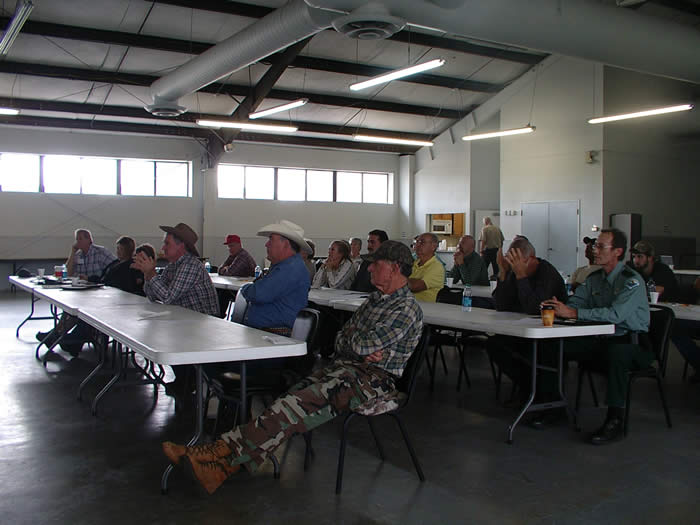
by Matthew Orwat | Jul 8, 2014
 Core, Ornamental and Turf
Core, Ornamental and Turf
Pesticide Training & Exam
July 31, 2014
8:00 am – 5:00 pm
***** 2 CEUs available in CORE and 2 CEUs available in O&T*****
 Location: Washington County Extension Office, at the Agriculture Center
Location: Washington County Extension Office, at the Agriculture Center
1424 Jackson Ave. Chipley, Fl. Suite A
East Wing Conference Room
To Register Contact Matt or Cynthia at 850-638-6180 or mjorwat@ufl.edu .
Cost:
$20.00 all day
Or
$10.00 if only attending morning or afternoon session
Agenda:
CORE Training and Exam section
- 7:45-8:00 — Registration and Introduction (morning refreshments)
- 8:00-9:40 Pesticide Effects on Humans and the Environment
- 9:40 – 10:50 Pesticide Labeling
- 11:00-12:30 CEUs Issued / Exam
- 12:30-1:30—Lunch (provided)
Ornamental & Turf Training and Exam section
- 1:30-2:20 Identifying and Controlling In-sects,Weeds and Disease
- 2:20-3:30 Reading Herbicide Labels and Calculating Application Rates
- 3:30-5:00 CEUs Issued / Exam

by Taylor Vandiver | Jul 1, 2014
The summertime often reminds us of our uninhibited spirit. With Independence Day not far off, Floridians will be celebrating the freedom of our nation while battling the oppressive climate you can’t seem to escape this time of year. As we approach the apex of heat and humidity here in Florida, we would do well to remember the tenacity of our native wildflowers and their “spirited” survival of Florida’s extreme conditions.
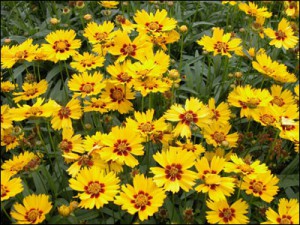
Coreopsis flowers. Photo courtesy UF/IFAS.
Historically, Florida’s landscape was alive with color throughout the seasons. Through urbanization and cultivation we’ve lost a large part of that legacy; however, we can reestablish some of Florida’s colorful past in our own yards and neighborhoods.
In order to ensure successful planting of wildflowers it is important to properly select and prepare your site. You will want to choose a sunny-well drained area and cut any existing vegetation to the ground. It may be beneficial to put down sheets of cardboard to smother what’s left of the vegetation. This is best done in the summer in advance of fall planting.
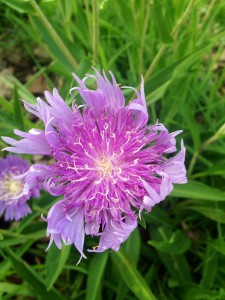
Stokes’ Aster in bloom.
Planting is best done late August to early September in North Florida. Soil-to-seed contact is critical so 1 day before seeding, or just prior to seeding, firmer soils need to be lightly scratched with a rake. Sandy soils might have to be made more firm to ensure that seed do not sink too deep. Broadcast the wildflower seeds at the recommended rate then press them into the soil by walking around on the planting site.
Wildflower seeds require adequate moisture during germination. After planting irrigate the site with about 1/4 to 1/2 inch of water daily for the first few weeks. After that, irrigate with about 1/2 inch water only if the wildflowers show signs of drought stress. Once established though, the meadow needs very little, if any, irrigation. Fertilizers should be avoided altogether as they promote the growth of aggressive weeds. Many of Florida’s native wildflower species are adapted to and perform well in soils with low fertility. Your wildflowers will re-send themselves if given the opportunity so wait until seed have matured before deadheading or mowing. Cut no lower than six to eight inches to avoid damaging the crowns of grasses and wildflowers.
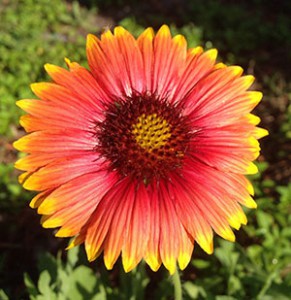
Native Gaillardia. Photo courtesy UF/IFAS.
To successfully cultivate a wildflower meadow in your home landscape, it’s helpful to select plants with the qualities to fit the conditions at your site. Also, consider blooming dates of flowers in order to provide color and interest for your landscape spring through fall. While not always possible, it’s best to purchase seeds and plants known to be Florida ecotypes. Consult with local nurseries and garden centers for more information on plant and seed availability and seeding rates. You can always contact your local Extension Office for more information. Other good sources of information are the Wildflower Seed And Plant Growers Association, Inc. (www.floridawildflowers.com); Association of Florida Native Nurseries (www.afnn.org); and the Florida Wildflower Foundation (www.floridawildflowerfoundation.org).
Growing wildflowers can restore a special sense of natural history close to home. So if you are looking for an “explosion” of color that will stand the test of time, Florida’s native wildflowers will not disappoint.
by Eddie Powell | Jul 1, 2014

Tomato spotted wilt on leaves
Photo Credits: IFAS
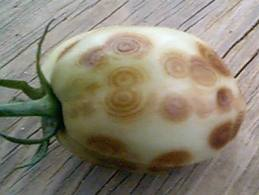
Tomato Spotted Wilt on Fruit
Photo Credit: IFAS
The spotted wilt virus has a wide host range and can affect tomatoes, peppers, plus many other vegetables and ornamental plants. Early symptoms of spotted wilt on tomato are difficult to diagnose. Young, infected plants may show an inward cupping of leaves, and the foliage may appear light color or have a slight bronze cast. As the disease progresses, plants may develop dark brown to black streaks on the main stem. Occasionally the top portion of the plant appears yellow or wilts.
The most characteristic symptom of spotted wilt appears on the fruit. On young fruit white to yellow concentric rings will develop on the fruit skin. The area within the ring typically is raised, which gives the fruit a bumpy appearance. The bright yellow rings on mature red fruit are easily diagnosed as spotted wilt.
The spotted wilt virus is transmitted from plant to plant by several species of a small insect called a thrips. Thrips are less than ¼ inch in length, light green to brown in color and are extremely difficult to find on the plants. It is very important to keep the weeds around the garden controlled because many weedy plants serve as alternate hosts for the virus vectors.
Virus diseases cannot be controlled once the plant is infected. So plant resistant varieties*! Sanitation will help with controlling virus diseases. Infected plants should be removed immediately to prevent spread of the pathogens. Perennial weeds, which may serve as alternate hosts, should be controlled in and adjacent to the garden. Avoid planting tomatoes next to peppers, or other vegetables and flowers susceptible to these diseases. Preventative control of insects, especially thrips, will help reduce the likelihood of spotted wilt.
*BHN 602, Amelia, Crista, Quincy, Bella Rosa, Top Gun, Fletcher, Mountain
by Julie McConnell | Jul 1, 2014
Panhandle residents have seen caterpillars in abundance this June. One common visitor to pecan trees is the Walnut Caterpillar Datana integerrima. The walnut caterpillar has a very narrow host range and feeds only on trees in the Juglandaceae family which includes walnut, pecan, and hickory trees. They are sometimes seen on other plant material, but feeding on non-host plants is unlikely.
Walnut caterpillar feed on the leaves of host trees through several growth stages and molts until they have reached the final larval instar and are ready to pupate into an adult moth. Their color changes from light green when newly hatched to reddish-brown to almost black with long white hairs as they mature. The caterpillars group together in large masses and may hang from each other and dangle from the tree branches when molting. Instead of creating a cocoon in the tree, the walnut caterpillar moves to the ground beneath the tree and burrows into the soil or leaf litter to pupate and emerges later as a moth.
What can you do if your pecan tree is hosting walnut caterpillars?
Although the numbers seen on trees may be alarming, a healthy tree can tolerate some feeding damage. Stripped branches may increases the chance of a lower yield of fruit because the removal of leaves does reduce the amount of energy the tree can produce, but overall health of the tree should not be significantly affected. However, many homeowners find falling caterpillars and their excrement unappealing and may decide to take steps to manage the population.
There are several natural enemies that feed on caterpillars, so avoid using a broad spectrum insecticide that might harm predatory insects and other animals. Consider using a biological control product such as Bt (Bacillus thuringiensis) that is only lethal to caterpillars. Other methods are “pick and squish” or drowning in a bucket of soapy water. Next year, in the spring, watch for masses of tiny green eggs on the underside of leaves and remove and destroy them before hatching.
For more information visit USDA Forest Service Forest Insect & Disease Leaflet 41 “Walnut Caterpillar”

 Core, Ornamental and Turf
Core, Ornamental and Turf Location: Washington County Extension Office, at the Agriculture Center
Location: Washington County Extension Office, at the Agriculture Center




